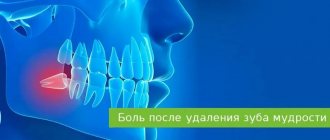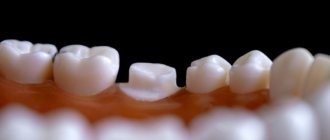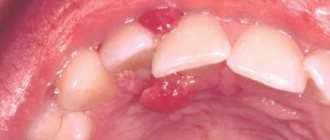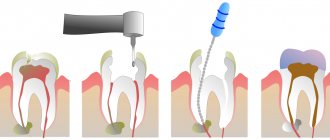Injection anesthesia is the most common method of anesthesia in dentistry.
Many people experience discomfort after dental treatment. Quite often, patients begin to experience pain from the administration of the anesthetic.
The problem is addressed after a day from all dental procedures, since before that the painkillers were still in effect. If your gums hurt after an anesthesia injection and the discomfort only increases within 24 hours, you should immediately contact the clinic.
After treatment and tooth extraction, pain often occurs at the site of injection of the anesthetic. Sometimes pain can be accompanied by swelling and impaired sensitivity of the soft tissues of the oral cavity.
Possible reasons for the appearance of a lump on the gum after tooth anesthesia
Since the doctor makes the injection blindly, there is a risk of hitting a blood vessel. This explains why a bruise appears on the cheek or gum. In many cases it is considered the norm. Hematoma may also occur while taking certain medications that affect the blood's ability to clot. This could be, for example, Heparin, Aspirin, and many NSAIDs. A number of factors contribute to the appearance of a lump after the administration of an anesthetic:
- drinking alcoholic beverages before visiting the dental office;
- high blood pressure - hypertension;
- consuming too hot food or drinks shortly after dental treatment.
Swelling near the injection site is not considered a deviation from the norm. Often such manifestations are subjective in nature - a person may feel severe tissue swelling, although in fact the swelling is insignificant. But in some cases, these signs can lead to complications, so it is necessary to understand when the pathological process develops.
Dangerous symptoms
Today, laser caries treatment is often used. Such manipulations do not cause pain if the dentist follows the technology. No painkillers are required. This therapy technique is especially suitable for those who are afraid of injections. The use of this method of treatment eliminates the drill and vibrations from it. This therapy is also comfortable for the patient.
If you experience an unpleasant symptom after the injection and it does not go away within 3-4 days, you should consult a doctor. Serious symptoms that indicate a problem may include gumboil and abscess, ulcers and spots on the gum tissue, or the formation of a large cyst. In such a situation, you should not hesitate to visit the doctor, so as not to worsen the consequences.
Why does pain occur after an injection into the gum?
Since the needle is inserted into soft tissues, it injures them and provokes discomfort. The patient may feel pain at the injection site for 1-2 days, or even more. The duration of the recovery period depends on the characteristics of the body and the perception of stimuli at the neuropsychic level.
Overly sensitive patients should be prepared for aching pain. Most often, no action is required. Usually the pain subsides on its own. In the case when it does not go away and only gets worse over time, we can talk about the development of a complication. At the same time, other signs of disturbances may occur.
Sometimes the patient thinks that the injection site hurts, but the localization is in a different place. So, after caries treatment, you may feel aching pain that radiates to the gums. Removal of a wisdom tooth is accompanied by pain in the socket, while the patient thinks that the problem is localized at the injection site.
Features of anesthesia
Today in dentistry, pain relief is very often used by injecting an anesthetic with a syringe. This is convenient for the dentist and makes it possible to reliably turn off sensitivity during any surgical interventions. You can learn how the most common types of pain relief in dentistry are performed by watching the video in this article.
Infiltration and conduction techniques are mainly used. The big advantage is that this allows you to act locally without having a toxic effect on the entire body.
Infiltration anesthesia is carried out directly in the area of the problem area. Conduction anesthesia affects the branch of the nerve responsible for a specific area of innervation. This technique is necessary for more extensive medical interventions.
Infiltration anesthesia on the upper jaw
Many people are concerned about the question: does it hurt to give anesthesia to the gums? Of course, the procedure is not pleasant.
Before carrying out the manipulation, for particularly sensitive patients, dentists irrigate the injection site with anesthetics in an aerosol. However, recently very thin needles have been used for carpule syringes, which minimally injure soft tissues.
Complications after injection of anesthetic into the gums
Depending on the amount of blood released from the vessel and the individual characteristics of the body, it often takes 4 to 10 days for a bruise on the gum to disappear. Otherwise, this is already a complication.
| Type of complication | Features of manifestation | Symptoms |
| Accession of infection | There are always millions of bacteria in your mouth. In a normal state, they are in a certain balance, but under favorable conditions, for example, when immunity decreases, they can be activated. Thus, clotted blood becomes a nutrient medium for them. Pathogens begin to multiply. Pathogenic microorganisms can spread to periodontal tissue, the alveolar process that holds the tooth, periosteum and bone. Much depends on the type of pathogen and the location of the bruise. | Tissue infection is accompanied by the following symptoms: · painful sensations; · temperature increase – up to 39 ˚С; · weakness; · headache; Redness of the gum tissue. |
| Damage to the nerve trunk | If the doctor acts incorrectly, nerve fibers may be damaged as a result of the administration of anesthesia. In this case, it is important to contact a neurologist and maxillofacial surgeon as quickly as possible. | The patient feels a sharp pain immediately when the injection is given. It will subside for the duration of the anesthetic, but then resume again. It cannot be stopped even with the help of painkillers. If a large nerve trunk is affected, pain will be felt throughout the entire mouth, cheek and ear. It is even possible to turn off the chewing function and numbness of the face. Sometimes it is difficult to open your mouth completely; one side may sag. |
| Tissue necrosis | A very dangerous complication. The reason for its development may be the patient’s ailment, which he was silent about, vasospasm, too much anesthetic or its rapid administration. | The patient first feels a sharp, growing pain. It subsides for a short time, but this does not indicate that the danger has passed. The pain disappears due to tissue death. |
Complications after tooth extraction often occur due to the penetration of bacteria through the hole into various tissues of the dentofacial apparatus. Pus accumulates.
After the injection my gums hurt: is this normal?
28.10.2018
- What causes gum pain after an injection?
- What should I take to relieve the pain from the injection?
- Folk remedies for gum pain.
Most dental procedures are accompanied by pain relief with injections, which helps people avoid pain and discomfort. The anesthesia wears off after a couple of hours, leaving no traces at the injection site. Sometimes it is expressed by swelling of the gums, discomfort and pain that haunt the patient for up to several days. Then you should urgently visit a specialist.
A high-quality injection is used in almost every procedure. Often one of the following methods is used:
- Infiltration - injection close to the site of inflammation.
- Conductive - anesthesia of the nerve trunk area, allowing to “freeze” periodontal tissue for up to 10 hours.
Accuracy and quality of treatment does not exclude the problem of pain in the gums after injection. This is normal, since the needle damages periodontal tissue. For 24 hours, the pulling sensation after a visit to the dentist should not cause concern.
Pain after an anesthetic injection - the main causes
The patient's response to anesthesia will depend on his sensitivity threshold and age category. Its duration ranges from 2 hours to several days. If gum pain at the injection site bothers you for longer, you should consult your doctor.
The following complications are common:
- An abscess (suppuration) is an infection of soft tissue; characteristic symptoms are the formation of swelling, burning and painful pulsation.
- A hematoma is damage to a small capillary, which leads to the accumulation of blood under the mucosa and the formation of a dark-colored bulge or lump.
- Nerve trunk injury is a disruption of nerve fibers due to a needle entering a sensitive ending, which leads to pain spreading to the cheek, temporal lobe and behind the ear.
- Postoperative pain irradiation. When removing an abscess in a tooth root or fistula, it appears that the gums in the injection area hurt.
The most serious cause of pain is the death of the mucous membrane. Necrosis is caused by:
- Too rapid administration of anesthesia;
- Error in calculation and increased dose of adrenaline;
- Problematic blood circulation as a result of a chronic disease;
- Administration of drugs that can initiate mucosal rejection.
How to relieve pain after an injection in the gum?
Taking antibiotics will stop the inflammatory process in the jaw and slow down infection. Experts recommend: Lincomycin; Amoxiclav; Sumamed.
To eliminate the side effect and protect the intestines, prebiotics and probiotics (Linex, Bifidumbacterin or Bifiform) are prescribed in parallel.
The intensity of the pain influences the choice of drug that will relieve the attack for a long time. A common and powerful way is to:
- Ibuprofen;
- Nurofen;
- Naiza;
- Ketanova;
- Diclofenac with paracetamol.
The dentist opens the formed abscess using antiseptic applications. A rinsing procedure with Chlorhexidine or Miramistin is also prescribed.
Folk remedies for relieving pain after an injection in the gum
Among folk remedies, doctors recommend treatment with soda solution and anti-inflammatory herbal decoctions. Often used:
- Sage;
- Chamomile;
- Calendula tincture;
- Oak bark;
- Yarrow;
- Propolis.
Sea buckthorn oil and the application of crushed aloe leaf also contribute to the restoration of a fistula or wound. It is forbidden to use an alcohol rinse, warm a swollen cheek or warm a sore gum.
Do not treat yourself. Even massage of the gums can provoke a rush of blood, which will lead to increased pain. Follow oral hygiene and the dentist’s recommendations, which will help avoid necrotic processes and reduce the risk of other complications.
Reason to see a doctor
The following symptoms require a visit to the dental office:
- severe pain at the injection site and its increase;
- significant swelling of the gums that remains after the anesthesia wears off;
- purulent or sanguineous discharge from gum tissue;
- temperature increase;
- compaction (“petrification”) of gum tissue in the affected area;
- looseness of the gums under the tooth, which was amenable to treatment, their slight displacement when exposed.
During the examination, the doctor will determine the cause of the development of undesirable effects.
What can you do at home?
When discomfort is felt in the gum tissues, or a sore throat after dental anesthesia, you need to make an appointment with a doctor. Before going to the clinic, you need to follow simple rules.
- Do not include too cold or hot foods in your diet, as the gums are vulnerable and react painfully to irritants.
- Teeth should be brushed with a cool brush.
- It is impossible to mechanically influence the gingival tissue. The pressure should be light.
- Do not apply garlic, pepper, or mustard to the affected mucous membrane.
- Several times a day you should rinse your mouth with a salt solution, a water decoction of chamomile or sage. Particular attention should be paid to diseased areas.
Such activities will ease the condition before visiting a doctor. After the procedure, the dentist may prescribe medications to relieve pain. The most commonly prescribed drug is Nise, a strong drug that relieves muscle pain. Ketanov is an effective remedy. Dexalgin acts for a long time and quickly. For minor pain, baralgin is used. Nurofen works well on soft tissues. At elevated temperatures and inflammatory processes, it is recommended to use paracetamol.
Why can your gums hurt?
Why does my gum hurt? Firstly, this is a natural reaction. You have undergone surgery to remove a tooth and its root system. Obviously, the surrounding tissue will be sore for several hours after the anesthesia wears off. Tissue swelling affects the nerve endings, which causes discomfort. If the pain is too severe, you can take a pain reliever as recommended by your doctor.
The fate of the gum tissue for the next few days depends on the fulfillment of the surgeon’s instructions. If your gums are still inflamed, or you feel any unpleasant symptoms that the doctor did not warn you about, you need to make an urgent appointment with the dentist.
One of the causes of gum inflammation can be the entry of food particles, spices, or exposure to hot temperatures into the socket. To protect your gums, it is necessary to limit visits to saunas and steam baths, and exposure to the sun. Temperature increases blood circulation and provokes an inflammatory process.
Another cause of gum problems can be careless brushing of teeth. You need to very carefully carry out home oral hygiene, without affecting the socket and the area around it.
You should also remember that any manipulations with the hole are strictly prohibited. You should not try to pull out food particles or remove clots on your own. If the dentist prescribed ointment, you must use it. If nothing is prescribed, then there is no need to use additional funds.
After tooth extraction surgery, your doctor should warn you about possible pain and complications. An additional cause of gum problems may be the presence of splinters in the tissues or incorrect actions by the dentist.
Pathogenesis
The occurrence of a hematoma in dentistry is usually caused by mechanical trauma to the oral cavity - unsuccessful surgery, tooth extraction, anesthesia injection. Domestic injuries are possible; people with poor blood clotting and older people are especially susceptible to this disease.
Stages of hemotoma development
- Red hematoma is bleeding into the surrounding tissue of red blood cells. Vascular rupture, thrombosis.
- Blue hematoma (2–3 days) - venous stagnation, changes in corpuscles.
- Green hematoma (4-5 days) - formation and release of hemasiderin.
- Yellow hematoma (6-7 days) - resolving therapy is recommended.
- If the process lasts for more than a month, ulcers and erosion may develop.
Symptoms
- Rising body temperature
- Pain on palpation
- Spontaneous throbbing pain
- Tissue compaction
- Tissue swelling
- Change in color of damaged skin
- Swelling of the mucous membrane
Why do bruises appear after implant placement?
Bruises are formed due to damage to small blood vessels, hematomas are the result of deep damage to soft tissues followed by muscle hemorrhage. Such reactions are located in the gums, but sometimes, due to inflammation in the area where the titanium structure is implanted, they move outward.
Reasons for development:
- An insufficiently experienced implantologist - due to inexperience, the facial nerve or artery may be affected.
- Intolerance to materials and medications used during implantation.
- Anatomical features of the patient’s body (rate of blood clotting, tissue regeneration).
- Violations at the stage of preparation for implant installation.
- Failure by the patient to follow medical recommendations at the postoperative stage.
How to eliminate cheek swelling
It is impossible to get rid of edema 100% before the inflammatory process stops. To reduce discomfort and pain, you can apply cooling compresses for 7-10 minutes with a break of 30-40 minutes. Taking painkillers, baths and rinsing with soothing solutions at room temperature helps.
How to remove cheek swelling after tooth extraction at home
- Avoid contact with the hole. It should not be touched with the tongue, brushed, or allowed to get in contact with food.
- Adhere to dietary restrictions. You should not eat or drink for 4 hours after removal. In the next week, food should be soft, at room temperature, not hot or spicy. Eating sweets is not advisable.
- In the first 3-4 hours after removal, apply cooling compresses to the cheek. It is optimal to keep the compress for 3-5 minutes, maximum – 10-15. The compress can only be done on the first day.
- Rinse your mouth with an antiseptic solution. The main thing is to follow all the dentist’s instructions.
Reasons why the cheek swells after tooth extraction
Swelling appears due to the inflammatory process occurring in the mucosa and pulp after surgery. This is a non-infectious inflammation. If operations are carried out correctly and the surgeon’s instructions are followed, the swelling goes away painlessly and without the need to take antibiotics. The integrity of the oral mucosa is disrupted during doctor intervention. The more swollen the gums are after tooth extraction, the more the integrity of the mucous membrane is damaged.
Severe swelling most often appears in patients who have had their wisdom teeth extracted - they generally have large, intertwined roots that complicate the process. The same applies to situations where inflammation began before surgery.
Cheek swelling during wisdom tooth removal
Working with outer teeth is a complex operation. Therefore, swelling always occurs after wisdom teeth removal. Doctors often resort to cutting the gums, after which they apply stitches.
For two to three days after surgery, the temperature may remain above 37℃, and opening the mouth, talking and swallowing may be accompanied by pain. The risk of infection and serious inflammation is higher than with other tooth extractions. The surgeon must prescribe baths with an antiseptic solution and antibiotics. Additionally, it is recommended to eat soft, pureed foods at room temperature, and refrain from sweets, alcohol and smoking.











